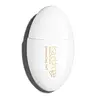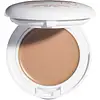What's inside
What's inside
 Key Ingredients
Key Ingredients

 Benefits
Benefits

 Concerns
Concerns

 Ingredients Side-by-side
Ingredients Side-by-side

Water
Skin ConditioningCoconut Alkanes
EmollientIsodecyl Neopentanoate
EmollientGlycerin
HumectantDimethicone
EmollientPEG-30 Dipolyhydroxystearate
EmulsifyingC12-15 Alkyl Benzoate
AntimicrobialSilica
AbrasiveCoco-Caprylate/Caprate
EmollientPolyglyceryl-4 Isostearate
EmulsifyingCorn Starch Modified
AbsorbentOpuntia Ficus-Indica Seed Oil
EmollientHelianthus Annuus Seed Oil
EmollientHydrogenated Castor Oil
EmollientTocopherol
AntioxidantPropylene Carbonate
SolventSqualane
EmollientDimethicone/Vinyl Dimethicone Crosspolymer
Skin ConditioningSalicylic Acid
MaskingSodium Chloride
MaskingSodium Hydroxide
BufferingGlyceryl Caprylate
EmollientSodium Benzoate
MaskingPhenoxyethanol
PreservativeStearalkonium Hectorite
Gel FormingIron Oxides
CI 77492
Cosmetic ColorantCI 77499
Cosmetic ColorantCI 77491
Cosmetic ColorantWater, Coconut Alkanes, Isodecyl Neopentanoate, Glycerin, Dimethicone, PEG-30 Dipolyhydroxystearate, C12-15 Alkyl Benzoate, Silica, Coco-Caprylate/Caprate, Polyglyceryl-4 Isostearate, Corn Starch Modified, Opuntia Ficus-Indica Seed Oil, Helianthus Annuus Seed Oil, Hydrogenated Castor Oil, Tocopherol, Propylene Carbonate, Squalane, Dimethicone/Vinyl Dimethicone Crosspolymer, Salicylic Acid, Sodium Chloride, Sodium Hydroxide, Glyceryl Caprylate, Sodium Benzoate, Phenoxyethanol, Stearalkonium Hectorite, Iron Oxides, CI 77492, CI 77499, CI 77491
Titanium Dioxide 13.7%
Cosmetic ColorantZinc Oxide 4.9%
Cosmetic ColorantDimethicone
EmollientHydrogenated Polyisobutene
EmollientPhenyl Trimethicone
Skin ConditioningIsodecyl Neopentanoate
EmollientSqualane
EmollientTalc
AbrasiveEthylhexyl Hydroxystearate
EmollientPolyethylene
AbrasiveIron Oxides
Polymethyl Methacrylate
Silica
AbrasivePolyglyceryl-3 Diisostearate
EmulsifyingAlumina
AbrasiveStearic Acid
CleansingWater
Skin ConditioningBeeswax
Emulsion StabilisingBHT
AntioxidantCaprylic/Capric Triglyceride
MaskingMicrocrystalline Wax
Emulsion StabilisingPhenoxyethanol
PreservativeTocopherol
AntioxidantTocopheryl Glucoside
EmollientTribehenin
EmollientTriethoxycaprylylsilane
CI 77891
Cosmetic ColorantCI 77492
Cosmetic ColorantCI 77491
Cosmetic ColorantCI 77499
Cosmetic ColorantTitanium Dioxide 13.7%, Zinc Oxide 4.9%, Dimethicone, Hydrogenated Polyisobutene, Phenyl Trimethicone, Isodecyl Neopentanoate, Squalane, Talc, Ethylhexyl Hydroxystearate, Polyethylene, Iron Oxides, Polymethyl Methacrylate, Silica, Polyglyceryl-3 Diisostearate, Alumina, Stearic Acid, Water, Beeswax, BHT, Caprylic/Capric Triglyceride, Microcrystalline Wax, Phenoxyethanol, Tocopherol, Tocopheryl Glucoside, Tribehenin, Triethoxycaprylylsilane, CI 77891, CI 77492, CI 77491, CI 77499
Ingredients Explained
These ingredients are found in both products.
Ingredients higher up in an ingredient list are typically present in a larger amount.
Ci 77491 is also hydrated iron III oxide. It's sole purpose is to give a red/pink hue to products.
Iron III oxides are classified as inorganic chemicals for coloring.
Synthetically created Ci 77491 is considered safer than those naturally found. This is because the synthetically created version may contain less impurities. Iron oxides are generally non-toxic and non-allergenic.
Learn more about CI 77491Ci 77492 is also hydrated iron III oxide. It's sole purpose is to give a yellow hue to products.
Iron III oxides are classified as inorganic chemicals for coloring.
Synthetically created Ci 77492 is considered safer than those naturally found. This is because the synthetically created version may contain less impurities. Iron oxides are generally non-toxic and non-allergenic.
Learn more about CI 77492Ci 77499 is also hydrated iron III oxide. It is created from mixing red and black iron oxides. This helps give shades of darkness to a product.
Iron III oxides are classified as inorganic chemicals for coloring.
Dimethicone is a type of synthetic silicone created from natural materials such as quartz.
What it does:
Dimethicone comes in different viscosities:
Depending on the viscosity, dimethicone has different properties.
Ingredients lists don't always show which type is used, so we recommend reaching out to the brand if you have questions about the viscosity.
This ingredient is unlikely to cause irritation because it does not get absorbed into skin. However, people with silicone allergies should be careful about using this ingredient.
Note: Dimethicone may contribute to pilling. This is because it is not oil or water soluble, so pilling may occur when layered with products. When mixed with heavy oils in a formula, the outcome is also quite greasy.
Learn more about DimethiconeWe don't have a description for Isodecyl Neopentanoate yet.
Phenoxyethanol is a preservative that has germicide, antimicrobial, and aromatic properties. Studies show that phenoxyethanol can prevent microbial growth. By itself, it has a scent that is similar to that of a rose.
It's often used in formulations along with Caprylyl Glycol to preserve the shelf life of products.
Silica, also known as silicon dioxide, is a naturally occurring mineral. It is used as a fine, spherical, and porous powder in cosmetics.
Though it has exfoliant properties, the function of silica varies depending on the product.
The unique structure of silica enhances the spreadability and adds smoothness, making it a great texture enhancer.
It is also used as an active carrier, emulsifier, and mattifier due to its ability to absorb excess oil.
In some products, tiny microneedles called spicules are made from silica or hydrolyzed sponge. When you rub them in, they lightly polish away dead skin layers and enhance the penetration of active ingredients.
Learn more about SilicaSqualane is an emollient that helps the skin hold onto moisture. It's an oily liquid that occurs naturally in certain types of fish and plant oils.
Because squalane boosts hydration in the skin, it also comes with plenty of benefits: it is an antioxidant and can help fight free radicals and skin damage. Squalane is also found to have a detoxifying effect when applied.
Squalane comes from squalene, which occurs naturally within the sebum of our skin. It is one of the oils our skin produces to keep itself hydrated. Squalane is the hydrogenated version of squalene and has a longer shelf life.
Research shows that squalane is non-irritating (even at 100% concentration).
In general, it's a fantastic ingredient. It does a great job at hydrating the skin, and it's suitable for those with sensitive skin.
The source of squalane may impact malassezia / fungal acne. This is because olive oil derived squalane can contain impurities such as fatty acids and plant waxes. Sugarcane derived squalane is recommended for anyone with malassezia concerns.
Is squalane vegan?
This depends on the source. Squalane can be derived from both plants and animals. Most squalane used in skincare comes from plants.
Please note: the source of squalane is only known if disclosed by the brand. We recommend reaching out to the brand if you have any questions about their squalane.
Read more about squalene with an "e".
Is squalane an oil?
Squalane is often called an oil, but it’s technically not; it’s a hydrocarbon, meaning it’s only made of carbon and hydrogen, unlike true oils which are triglycerides made of fatty acids and glycerol.
The term “oil-free” isn’t regulated, so companies can define it however they want. Some exclude all oils, while others just avoid mineral oil or comedogenic oils.
While some people avoid oils thinking they cause breakouts, the right kind of oil (or oil-like ingredient like squalane) can actually help balance and hydrate your skin. It’s worth testing out simple oils or squalane to see what works best for your skin.
Learn more about SqualaneTocopherol (also known as Vitamin E) is a common antioxidant used to help protect the skin from free-radicals and strengthen the skin barrier. It's also fat soluble - this means our skin is great at absorbing it.
Vitamin E also helps keep your natural skin lipids healthy. Your lipid skin barrier naturally consists of lipids, ceramides, and fatty acids. Vitamin E offers extra protection for your skin’s lipid barrier, keeping your skin healthy and nourished.
Another benefit is a bit of UV protection. Vitamin E helps reduce the damage caused by UVB rays. (It should not replace your sunscreen). Combining it with Vitamin C can decrease sunburned cells and hyperpigmentation after UV exposure.
You might have noticed Vitamin E + C often paired together. This is because it is great at stabilizing Vitamin C. Using the two together helps increase the effectiveness of both ingredients.
There are often claims that Vitamin E can reduce/prevent scarring, but these claims haven't been confirmed by scientific research.
Learn more about TocopherolWater. It's the most common cosmetic ingredient of all. You'll usually see it at the top of ingredient lists, meaning that it makes up the largest part of the product.
So why is it so popular? Water most often acts as a solvent - this means that it helps dissolve other ingredients into the formulation.
You'll also recognize water as that liquid we all need to stay alive. If you see this, drink a glass of water. Stay hydrated!
Learn more about WaterThis ingredient is a combination of red, black, and yellow iron oxide pigments. This combination of colors is usually found in foundation, because it results in a "skin" color.